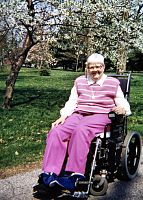The Good Life and Hard Times of Sister Peter Clare, CSC
Friday, Apr. 14, 2017
As we proceed through the holy season of Lent, seeking a deeper Christian life through self-denial, reflection and penance, it is well to realize that we are not confined to emulating the heroic deeds of the saints and martyrs throughout history, commendable though that is. Often those great exemplars of the faith can seem a goal too high, a model too unattainable to help us way down here where most of us live. Fortunately, we can often find much more approachable inspiration in the lives of people living just down the street or sitting at the other end of the pew, people whose quiet devotion to the Gospel carries them to great spiritual heights, sometimes despite great trials and even suffering. They show us that Christianity is not out of reach to any of us. One of them was Sister Peter Clare, CSC.
Imogene Berna was born in Orem, Utah in 1932, into a family suffering from great poverty: One of their homes was a tent erected on a concrete foundation. But her parents, Harvey and Pearl, were hard-working and frugal and eventually pulled themselves out of near-destitution. Harvey was a Methodist and Pearl had been baptized a Catholic but became inactive. The family converted to Mormonism in the late 1930s and moved to Salt Lake Valley.
When she was in the ninth grade, Imogene had a Damascus Road experience while watching the 1945 movie “The Bells of St. Mary’s,” with Bing Crosby and Ingrid Bergman, and determined to investigate Catholicism. She discovered St. Ann Orphanage in Salt Lake City, where she met Holy Cross Sisters Suzanne and Dolorissima who directed her to religious instruction and eventually to baptism in 1948 during her sophomore year in high school. Her mother was so impressed by her religious devotion that she received Holy Communion for the first time in many years at the same Mass where Imogene was baptized, and even Imogene’s Methodist father, who was reputed to have nothing good to say about Catholicism, entered the Church soon afterward.
Imogene’s conversion quickly led to suffering in the form of discrimination from her public school teachers and classmates who took a dim view of Catholicism, and she transferred to Judge Memorial Catholic High School for her junior and senior years.
But just being a Catholic was not enough for Imogene: The Holy Cross Sisters had had such an influence on her that she applied for admission to the order and was granted entrance in 1951 with the name Sr. Peter Clare. She entered upon a teaching career and served at schools in Tucson, Ariz. and in Salt Lake City, where she taught at the Bishop Glass School until her career was cut short by the onset of multiple sclerosis. She was forced into retirement at the order’s mother house in Notre Dame, Ind.
The form of MS that she had contracted was a particularly painful and debilitating one. It cost her her mobility, confining her to a motorized wheelchair for the rest of her life. That immobility was accompanied by periodic attacks of an acute facial pain called tic doloreaux, which neurologists identify as one of the worst pains a human being can experience.
For many of us, things would have looked pretty hopeless, but Sr. Peter Clare just shifted gears and turned her ministry in another direction. She ran Bingo games, delivered mail to the other Sisters, distributed candy and videotaped Mass. With her dear friend Sister Francelia, who also was in a motorized wheelchair, she zipped all over the Notre Dame campus and even went shopping at a nearby mall, both of the irrepressible Sisters wearing shades and looking like the Blues Sisters.
The two of them became great experts with the crochet hook and made various projects to be sold for the benefit of the Order, including a big crocheted Noah’s Ark with 15 different animals. Those who remember her recall that through the constant pain she was always cheerful, with a big smile and a hearty laugh. She died in 2010, leaving a big hole in the hearts of everyone she met.
We presently have need for role models like Sr. Peter Clare, in a time when even some of our highest leaders exemplify a headlong quest for wealth, power, sex, ego gratification and self-indulgence. Sr. Peter Clare never married a handsome young millionaire, she never owned a yacht or a sports car, she never lived in an expensive townhouse nor hung out with movie stars and celebrities. No, she chose a counter-cultural commitment to poverty, chastity and obedience – and nothing is more counter-cultural than those. She lived those ideals while confined to a wheelchair and accompanied by relentless excruciating pain. And she lived them with a never-failing exuberance, a ringing laugh and invincible good cheer. She demonstrated that a dedicated, purposeful life can bring great joy even when accompanied by great suffering.
Pray for us, Sr. Peter Clare!
Gary Topping is the Diocese of Salt Lake City archivist.
For questions, comments or to report inaccuracies on the website, please CLICK HERE.
© Copyright 2024 The Diocese of Salt Lake City. All rights reserved.
© Copyright 2024 The Diocese of Salt Lake City. All rights reserved.



Stay Connected With Us